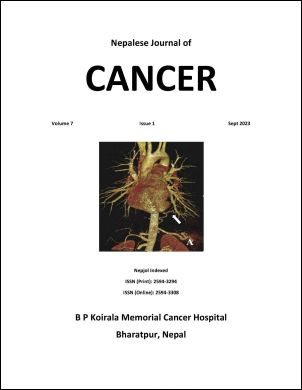Thoracoscopic biopsy in the diagnosis of lung and pleural diseases
DOI:
https://doi.org/10.3126/njc.v7i1.60023Keywords:
Thoracoscopy;, biopsy, pleural effusionAbstract
Background: Thoracoscopy is a useful procedure for evaluation and diagnosis of pleural effusion and other thoracic disorders. Our study aimed to evaluate the scope and use of thoracoscopic biopsy for the evaluation of thoracic disorders and report on the outcomes of this technique.
Methods: Patients undergoing thoracoscopic biopsy procedure from March 2022 to May 2023 were analyzed for indications, complication and outcomes.
Results: 85 patients underwent thoracoscopic biopsy over a period of 15 months, of which 38 (44.7%) were males and 47 (55.3%) were females. The mean age was 60 years. Cough, dyspnea and chest pain were the most common presenting symptoms. Thoracosopy was most commonly done on the right side (67.1%). Pleura (57.6%) was the most common biopsy site, followed by lungs (22.4%), lymph node (12.9%) and mediastinum (3.7%). One case was converted to open procedure. Post operative complication rate was 3.5%. Adenocarcinoma (31.8%) was the most common histology, followed by squamous cell carcinoma (9.4%). 36.5% patients had benign disease and 11.8% patients had metastatic extra-thoracic malignancy.
Conclusion: Thoracoscopy is a safe and simple procedure for diagnosis of pleural and other thoracic disorders with the advantage of tissue sampling from lesion under direct visualization. It is a useful tool in the armamentarium of thoracic surgeons.
Downloads
Downloads
Published
How to Cite
Issue
Section
License
Copyright (c) 2023 Nepalese Journal of Cancer

This work is licensed under a Creative Commons Attribution 4.0 International License.
This license lets others distribute, remix, tweak, and build upon your work, even commercially, as long as NJC and the authors are acknowledged.
Submission of the manuscript means that the authors agree to assign exclusive copyright to NJC. The aim of NJC is to increase the visibility and ease of use of open access scientific and scholarly articles thereby promoting their increased usage and impact.




